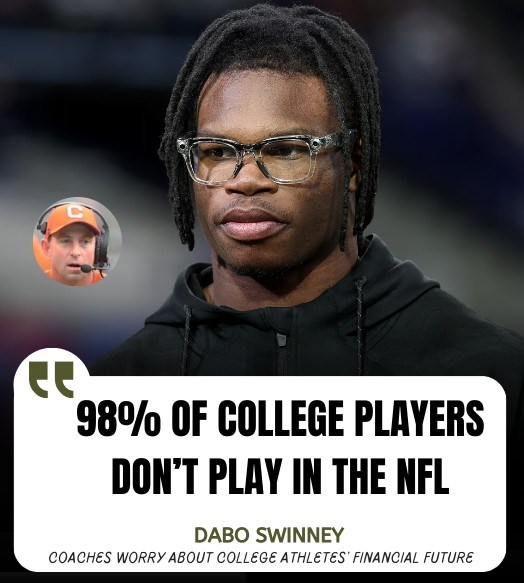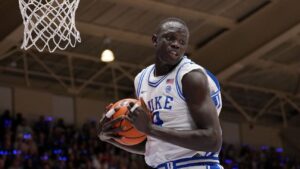
Navigating the Financial Playing Field: Protecting Athletes from Bankruptcy
The roar of the crowd, the thrill of victory, and the lucrative endorsement deals – these are often the hallmarks of an athlete’s career. However, beyond the bright lights and the roar of the stadium, a less glamorous and often devastating reality lurks: bankruptcy. The trajectory from athletic stardom to financial ruin is a well-documented phenomenon, affecting athletes across various sports and levels. Recent concerns voiced by Clemson Tigers head football coach Dabo Swinney regarding Name, Image, and Likeness (NIL) deals in college athletics have brought this issue into sharper focus. Swinney rightly points out that the vast majority of college football players, a staggering 98%, will not make it to the professional leagues. This stark statistic underscores the critical need for financial literacy and responsible money management for all student-athletes, especially in an era where NIL deals offer unprecedented financial opportunities, but also potential pitfalls. The fear that college athletes, suddenly managing significant sums of money, could follow the path of many retired professional athletes into bankruptcy is a valid and pressing concern.
The stories of professional athletes facing bankruptcy are numerous and serve as cautionary tales. From boxing legend Mike Tyson to NBA star Allen Iverson and baseball icon Curt Schilling, the list of athletes who have lost fortunes is extensive. These are individuals who reached the pinnacle of their sports, earning millions of dollars, yet ultimately found themselves in dire financial straits. The reasons behind these financial collapses are varied and complex, often involving a combination of factors such as poor investment decisions, extravagant lifestyles, predatory advisors, lack of financial education, and unexpected life events like injuries or lawsuits.
One significant contributing factor to athlete bankruptcies is the sudden influx of wealth at a young age. Many athletes turn professional in their early twenties, or even late teens, with little to no experience managing large sums of money. They are thrust into a world of agents, financial advisors, and endorsement opportunities, often without the foundational knowledge to discern sound advice from self-serving schemes. The allure of luxury goods, lavish parties, and supporting a large entourage can quickly deplete even substantial earnings. Without a strong understanding of budgeting, saving, and investing, athletes can easily fall victim to overspending and unsustainable lifestyles.
Furthermore, the relatively short careers of many professional athletes create a unique financial challenge. Unlike professionals in other fields who can expect decades of earning potential, athletes typically have a limited window to maximize their income. Injuries can prematurely end careers, and even the most successful athletes eventually face retirement. Without careful planning and wise investments, the earnings accumulated during their playing years may not be sufficient to sustain them for the rest of their lives.
The lack of financial literacy is another critical factor. Many young athletes come from backgrounds where financial education was not a priority. They may not have been taught the basics of managing money, understanding credit, or making informed investment decisions. While some professional sports leagues and teams offer financial education programs, these are not always comprehensive or effectively utilized. As a result, athletes may be ill-equipped to navigate the complexities of their financial lives and are more susceptible to making poor choices or falling prey to those who seek to exploit their wealth.
The rise of NIL deals in college athletics adds a new layer of complexity to this issue. While these deals provide student-athletes with the opportunity to earn money based on their name, image, and likeness, they also introduce new financial responsibilities and potential risks. College athletes, often even younger and less experienced than their professional counterparts, are now managing endorsement contracts, potential investments, and increased public scrutiny of their finances. Without proper guidance and education, they could be even more vulnerable to the pitfalls that have plagued professional athletes.
Dabo Swinney’s concern about the 98% of college football players who will not go pro is particularly relevant in this context. These student-athletes may experience a taste of financial independence through NIL deals but will not have the long-term, high-earning potential of professional athletes. It is crucial that they develop sound financial habits and understand the importance of saving and planning for their future beyond their athletic careers. The lessons learned – or not learned – during their college years can have a significant impact on their long-term financial well-being.
Addressing the issue of athlete bankruptcy requires a multi-faceted approach. Financial education must be a priority at all levels, from youth sports to professional leagues and college athletics. Comprehensive programs should cover topics such as budgeting, saving, investing, debt management, understanding contracts, and the importance of seeking trustworthy financial advice. These programs should be mandatory and ongoing, adapting to the evolving financial landscape and the specific needs of athletes at different stages of their careers.
Furthermore, there needs to be greater oversight and regulation of financial advisors who work with athletes. The prevalence of predatory advisors who take advantage of athletes’ lack of financial knowledge is a serious problem. Stricter regulations, increased transparency, and better vetting processes are needed to protect athletes from fraud and mismanagement of their funds. Professional athletes’ unions and governing bodies in college athletics can play a crucial role in advocating for these protections and providing resources for athletes to find reputable financial advisors.
Mentorship programs can also be invaluable. Pairing young athletes with retired professionals who have successfully managed their finances can provide guidance, support, and real-world examples of responsible money management. These mentors can share their experiences, offer advice on avoiding common pitfalls, and help athletes build a strong financial foundation.
Ultimately, the responsibility also lies with the athletes themselves to take an active role in their financial education and decision-making. While trusting advisors is important, athletes must also develop a basic understanding of their finances and be willing to ask questions and seek clarification. They need to be empowered to make informed choices and avoid blindly following advice without understanding the potential consequences.
In the context of NIL deals, colleges and universities have a crucial role to play in preparing their student-athletes for the financial realities they will face. This includes providing robust financial literacy programs that are tailored to the unique circumstances of college athletes. These programs should address topics such as understanding endorsement contracts, managing income from NIL activities, and the importance of long-term financial planning.
The concern raised by Coach Swinney serves as a timely reminder that the allure of immediate financial gain should not overshadow the importance of long-term financial security. While NIL deals offer exciting opportunities for college athletes, they also come with significant responsibilities. Without proper education and guidance, these young individuals could be setting themselves up for the same financial struggles that have plagued many professional athletes.
The goal should be to equip athletes at all levels with the knowledge and skills they need to navigate the financial playing field successfully. By prioritizing financial literacy, promoting responsible money management, and providing adequate support and resources, we can help athletes avoid the devastating consequences of bankruptcy and ensure a more secure financial future, regardless of their professional athletic outcomes. The lessons learned early on, especially for the 98% who will transition to careers outside of professional sports, will be invaluable in building a foundation for lifelong financial well-being.





